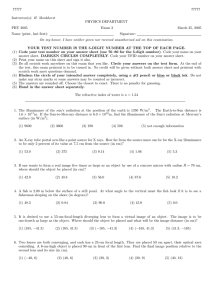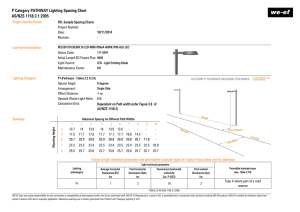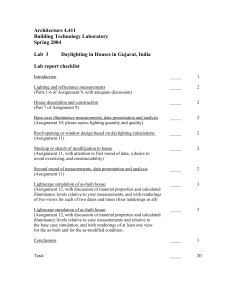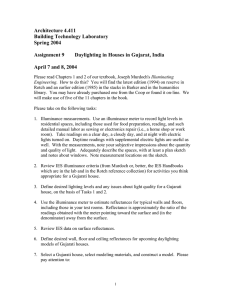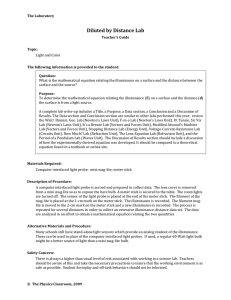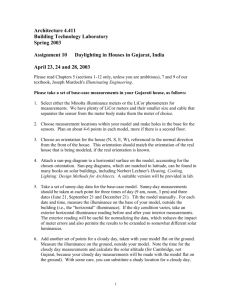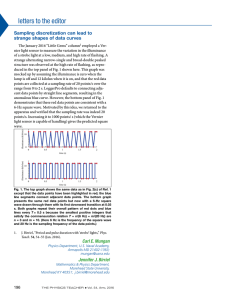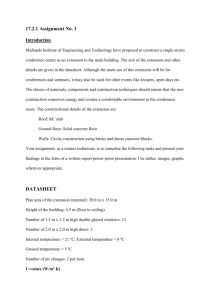Measurement of illuminance in electrically lit spaces
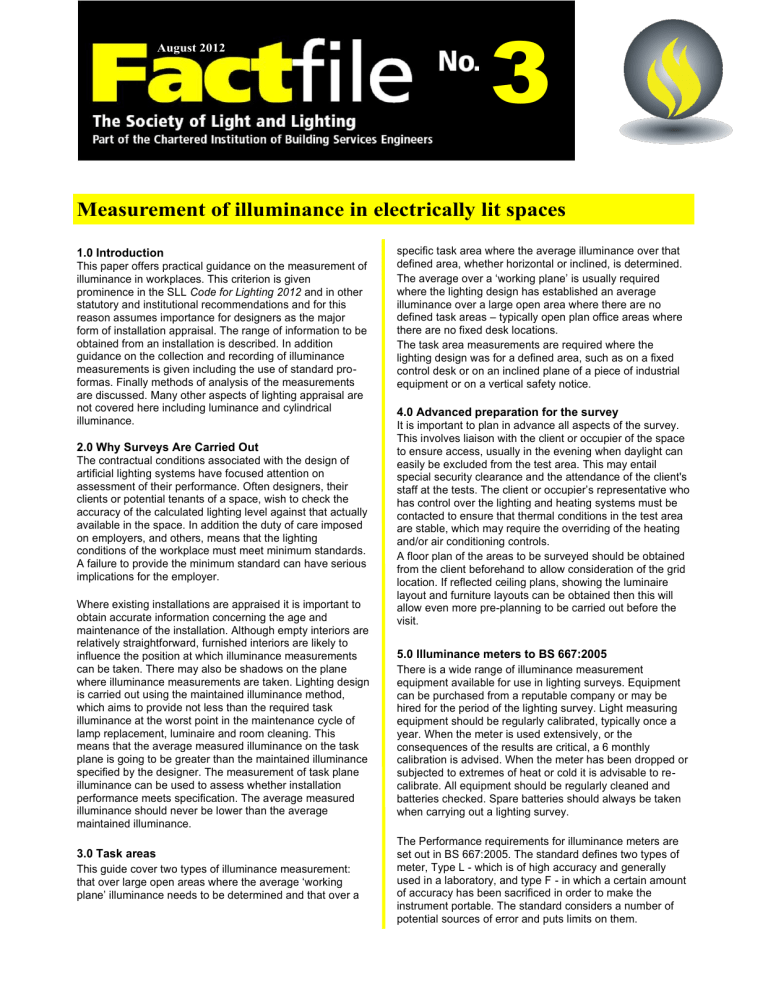
August 2012
3
1
Measurement of illuminance in electrically lit spaces
1.0 Introduction
This paper offers practical guidance on the measurement of illuminance in workplaces. This criterion is given prominence in the SLL Code for Lighting 2012 and in other statutory and institutional recommendations and for this reason assumes importance for designers as the major form of installation appraisal. The range of information to be obtained from an installation is described. In addition guidance on the collection and recording of illuminance measurements is given including the use of standard proformas. Finally methods of analysis of the measurements are discussed. Many other aspects of lighting appraisal are not covered here including luminance and cylindrical illuminance.
2.0 Why Surveys Are Carried Out
The contractual conditions associated with the design of artificial lighting systems have focused attention on assessment of their performance. Often designers, their clients or potential tenants of a space, wish to check the accuracy of the calculated lighting level against that actually available in the space. In addition the duty of care imposed on employers, and others, means that the lighting conditions of the workplace must meet minimum standards.
A failure to provide the minimum standard can have serious implications for the employer.
Where existing installations are appraised it is important to obtain accurate information concerning the age and maintenance of the installation. Although empty interiors are relatively straightforward, furnished interiors are likely to influence the position at which illuminance measurements can be taken. There may also be shadows on the plane where illuminance measurements are taken. Lighting design is carried out using the maintained illuminance method, which aims to provide not less than the required task illuminance at the worst point in the maintenance cycle of lamp replacement, luminaire and room cleaning. This means that the average measured illuminance on the task plane is going to be greater than the maintained illuminance specified by the designer. The measurement of task plane illuminance can be used to assess whether installation performance meets specification. The average measured illuminance should never be lower than the average maintained illuminance.
3.0 Task areas
This guide cover two types of illuminance measurement: that over large open areas where the average ‘working plane’ illuminance needs to be determined and that over a specific task area where the average illuminance over that defined area, whether horizontal or inclined, is determined.
The average over a ‘working plane’ is usually required where the lighting design has established an average illuminance over a large open area where there are no defined task areas – typically open plan office areas where there are no fixed desk locations.
The task area measurements are required where the lighting design was for a defined area, such as on a fixed control desk or on an inclined plane of a piece of industrial equipment or on a vertical safety notice.
4.0 Advanced preparation for the survey
It is important to plan in advance all aspects of the survey.
This involves liaison with the client or occupier of the space to ensure access, usually in the evening when daylight can easily be excluded from the test area. This may entail special security clearance and the attendance of the client's staff at the tests. The client or occupier’s representative who has control over the lighting and heating systems must be contacted to ensure that thermal conditions in the test area are stable, which may require the overriding of the heating and/or air conditioning controls.
A floor plan of the areas to be surveyed should be obtained from the client beforehand to allow consideration of the grid location. If reflected ceiling plans, showing the luminaire layout and furniture layouts can be obtained then this will allow even more pre-planning to be carried out before the visit.
5.0 llluminance meters to BS 667:2005
There is a wide range of illuminance measurement equipment available for use in lighting surveys. Equipment can be purchased from a reputable company or may be hired for the period of the lighting survey. Light measuring equipment should be regularly calibrated, typically once a year. When the meter is used extensively, or the consequences of the results are critical, a 6 monthly calibration is advised. When the meter has been dropped or subjected to extremes of heat or cold it is advisable to recalibrate. All equipment should be regularly cleaned and batteries checked. Spare batteries should always be taken when carrying out a lighting survey.
The Performance requirements for illuminance meters are set out in BS 667:2005. The standard defines two types of meter, Type L - which is of high accuracy and generally used in a laboratory, and type F - in which a certain amount of accuracy has been sacrificed in order to make the instrument portable. The standard considers a number of potential sources of error and puts limits on them.
Measurement of illuminance in electrically lit spaces cont...
Table 1 - Tolerances for illuminance meters
Source of error
Calibration uncertainty(1), %
10 - 10,000 lux
10,000 - 100,000 lux
Maximum error over effective range %
Type L Type F
1.0
1.0
2.5
3.0
Non-linearity %
10 - 10,000 lux
10,000 - 100,000 lux
Spectral correction factor,%
Infra-red response, %
Ultraviolet response
Cosine correction (unless marked as uncorrected), %
0.2
0.2
1.5
0.2
0.2
1.5
1.0
2.0
3.5
0.2
0.5
2.5
Fatigue, %
Temperature change, % per K
0.1
0.2
0.4
0.25
Range change 0.5 1.0
The standard used and errors involved should be quoted
NOTE 1. For digital displays there is a permitted tolerance of ± 1 on the least significant digit.
NOTE 2. A meter, which just meets the requirement of this standard, would have a best measurements capability of ±4% (type L) or ±6% (type F) when used on any of its calibrated
2
Table 1 above indicates the types of errors that are encountered with meters and their permitted limits.
The manufacturer will provide information concerning the temperature range over which the meter remains accurate.
Although this will probably include most building interiors, specialist industrial processes may need extremes of temperature. Manufacturers of photo-voltaic cells can supply correction factors for illuminance measurements when the meter is used in operating temperatures which differ from a normal value.
In many cases this is about
25°C. Selenium photocells are more sensitive to high temperature than silicon photocells, where prolonged exposure to temperatures above 50°C may cause permanent damage. An illuminance meter is shown on Figure
1.
The meters measure the photon impact intensity on
Figure 1 the surface of a photocell. The cell is able to use this energy to provide a small current which will vary in proportion to the photon impact intensity. Filters in front of the photocell correct the response for the spectral sensitivity of the eye (V(λ) correction). Circuitry in the meter amplifies this signal. The output can then be displayed as a reading calibrated in Lux, usually on a digital display, but sometimes on a moving coil needle gauge. It is common for meters to be provided with a range of full-scale readings.
The scale can be changed by control knobs or switches.
The meters are normally portable, hand-held and the photocell is usually attached to the amplifier by a flexible cable. This allows the photocell to be some distance from the person taking measurements, avoiding the risk of shadowing the photocell.
The photocell must be of the cosine corrected type. This is because when light is incident at less than 90° to the photocell surface, the response of the photocell must be modified by the cosine of the incident angle. This is achieved by a dome or disk of diffusing material being incorporated over the actual measuring cell.
The person making the measurements must be familiar with the use of the equipment. Time should be taken to read and understand the contents of the instruction book. Simple trial measurements are useful.
6.0 Equipment needed at the test
The other equipment needed for the survey may seem self evident but needs to be assembled and checked in advance if an abortive visit or wasted time is to be avoided.
A long tape measure, at least 7-10 metres, is needed to lay out the measurement grid. The grid itself can be marked-out
3
Measurement of illuminance in electrically lit spaces cont... by string or chalk marks on the carpet (if allowed); otherwise brightly coloured sticky dots or labels are needed to mark the grid intersection points so as to allow quick and accurate location of the measuring cell. It is possible to buy packs of pre-numbered dots which may help in identifying and recording the readings. Spare batteries for the light meter.
If measurements are to be carried out over empty areas or between desks then a portable stand will be needed to ensure the measuring cell is located at the ‘working plane’ height. This stand should be light but able to ensure that the measuring cell is horizontal and at the correct height for each reading. An example is shown in Figure 1.
Finally a clipboard or other firm writing surface, pens and paper should be obtained for the recording of the results. If pro-forma recording sheets, like that shown in Figure 6, are used then time is saved at the measuring site and the readings are more likely to be recorded without error.
Where a comparison is to be made between calculated illuminance figures and those measured it will be necessary to estimate the actual room surface reflectances. This can be done by using the colour matching chart included with
SLL Lighting Guide 11 ‘Surface reflectance and colour’ and using it to obtain a match against the room surfaces. The chart will then give a reflectance figure that can be used for calculating corrections between the recorded illuminance figures and those calculated.
7.0 Determining the number of measurement points required
The number of measurement points needs to be determined to give as accurate a result as possible without having to carry out an unnecessarily large number of measurements.
Methods are given below for determining the correct number and distribution of measuring points for both large open-plan areas and small individual task areas such as would be found on a fixed desk or industrial work plane.
7.1 Open-plan areas
For areas such as open-plan offices, where there are no fixed desk location, the measurement grid should be positioned to cover a representative area of the task plane.
This should be where there are no obstructions above the working plane, which may reduce the measured levels, that were not included as part of the lighting design for that task area. Where the measurements cover a large task area in an open-plan office space, where standard calculations and illuminance prediction are based on the assumption that there are no obstructions above the working plane, ensure that no partition screens, filing cabinets etc. above the level of the task plane in the measurement area.
In open-plan areas where there are different lighting levels for different functions, such as corridor routes or filing areas, then these must be understood and the measurement grid determined for each area separately. See figure 2
Figure 2 determine the distance between the points (p) use the formula: p = 0.2 x 5 log d
Where d is the length of the longer dimension of the area being measured.
For example is it is required to calculate the illuminance on an area 6m by 4m then formula may be applied: p = 0.2 x 5 log6 = 0.6997
However, if you divide the length of 6m by 0.6997 you get
8.575, so rounding up to the nearest whole number 9 measurement points are needed. Dividing 6 by 9 gives a true spacing of 0.666m. Then it is necessary to find the number of points in the width of the area that gives nearly the same spacing, in the case of the 6 by 4 area this is easy as a spacing of 0.666 means that 6 points are needed across the width. Once the number of points and the spacing has been calculated it is simple to arrange the points, with the first point starting a half spacing from the edge. If this half-spacing would put the first row or column within the 0.5m perimeter zone outside the core area then the first row or column should be on the 0.5m boundary.
(See figure 3).
Figure 3
Once the size of the area to be measured is known then the necessary number of points needed to obtain an accurate measured average illuminance can be calculated. To
Measurement of illuminance in electrically lit spaces cont...
4
7.2 Defined task areas
Where the task area to be measured is an individual defined area, such as on a work bench (figure 5), an inclined plane of a piece of industrial equipment or on a vertical safety notice then the first step is to define the size of task area clearly. Once the size is determined then the same calculation as given in 7.1 can be carried out to determine the optimum number of rows and columns of measurement points. Where the task area is of a non-rectangular shape, such as on the control desk illustrated in figure 4, then the area should be divided up into representative rectangular areas covering the main areas where tasks are performed.
8.0 THE SURVEY ITSELF
As the light output of lamps varies depending on their operating temperature, it is essential that the luminaires will have been operating under normal thermal conditions before measurements start. This may require, for example, both lighting and heating or air conditioning system to be switched on for long enough to achieve steady state conditions.
Initially the proposed test areas must be checked to ensure that they are representative of the working area and that all lamps and equipment are working correctly. Stray light from surrounding rooms and spaces should be screened from the test area unless the contribution of light from them was an intentional part of the design in providing the required lighting level in the test area. All light from external windows should be minimised by use of blinds, curtains, etc. Any automatic lighting control or daylight linked controls should be set such that the output of the lamps is at full power and will not vary during the tests. All lighting in the area that would normally illuminate the area test grid should be operating. A failure to allow the lamps to reach their normal operating temperature before taking illuminance measurements will mean that initial readings will be low.
Where lamps are known to be new they should be run for a minimum of 100 hours under normal operating conditions. A characteristic swirling pattern of light emission from fluorescent lamps may indicate that the lamps are new.
8.1 Recording Information
Figure 4
The following general information should be recorded: Date and time of test. Floor and area being measured. Those in attendance at the tests
The following should be obtained from the room:
Room Name/Reference Number
Plan Size
Floor to ceiling height and 'desk' height
Measurement grid and position
Size, shape and position of furniture, machinery and other room contents.
Luminaires:
Positions relative to measurement grid (mark lightly on grid plan). Type/make, size, number of lamps electrical rating, control gear mounting arrangement and orientation height if different from ceiling height.
Maintenance features: flicker, hum. broken diffusers, etc.
Maintenance regime: cleaning, relamping schedule, when last cleaned, approximate burning hours.
Reflection factors of surfaces (if required).
Figure 5
5
Measurement of illuminance in electrically lit spaces cont...
Take photographs where possible. These can be useful when considering the appearance effects of an installation and the type and nature of the room contents. Do not use a flash camera. The influence and relationship of daylight within the space should be noted. A scale plan, and possibly cross section, should be produced to show the position of the measurement grid, luminaires and room contents.
8.2 Checking the illuminance meter
Before use the illuminance meter should be checked for: battery condition, most recent calibration date, signs of wear/tear/damage cleanliness - particularly the cosine correction surface of the illuminance meter, correct functioning of control switches, providing readings at all scale ranges, the meter reads zero when the cell is completely covered
8.3 Taking and Recording Measurements
Once the grid has been defined it is relatively easy to take illuminance measurements at each point. This is achieved by placing a light meter at each point at the correct height and taking a measurement. The orientation of the light sensor is a function of the type of the measurement being taken. For horizontal illuminance it is necessary to ensure that the illuminance sensor is aiming straight up. For vertical illuminance it both necessary to keep the sensor vertical and ensure that it is parallel to the correct reference plane.
When readings are stable then measurements can begin.
Readings need to be taken at the task plane height used in the design calculation, or at the actual height if surveying an existing installation. This can be achieved using a portable stand, see Figure 1, which supports the cell at the required height and inclination (usually horizontal) over the grid intersection points set out on the floor of the room. All persons, except the light measurement team, should be excluded from the room in order to avoid shadowing or reflecting light on to the photocell.
Each measurement point can be described by a grid reference, letters and numbers as shown on Figure 6 The measurements at each grid intersection point must be recorded and an example of a typical pro-forma record sheet is shown as Figure 6. Care must be taken not to shadow the photocell when making measurements. This may require the person moving the photocell to crouch below the measurement plane level. It is convenient to have a second person recording the readings called out by the person moving the photocell.
9.0 Analysis of the Results
9.1 Average Illuminance and Diversity
The average illuminance is, strictly speaking, weighted in relation to the area of the grid 'squares', but since each of these is the same size, a simple arithmetic average of the measured values will suffice.
The illuminance diversity can be found by locating the minimum and maximum illuminance values on the grid of measured points and calculating the ratio of minimum to maximum values.
The results can be compared with those recommended in the SLL Code for Lighting. Any comparison must take account of the age and maintenance of the installation.
This is particularly important when considering Maintained
Illuminance.
9.2 Comparison of measurements and predictions
There is also a range of other factors associated with light output variation and illuminance measurement which will
Figure 6
6
Measurement of illuminance in electrically lit spaces cont... need to be considered when practical measurements are to be compared to computer predictions. These include room surface reflectance, mains voltage variation, lamp operating temperature, characteristics of the control gear and the lumen output of the lamps. These factors will influence the relative accuracy of the measured values when compared to computer predictions, although the input to the computer program may permit the use of the actual condition factors present at the time of the survey.
9.3 Task uniformity measurement and calculation.
A small amount of additional calculation is necessary if illuminance uniformity over task areas is to be checked.
Uniformity can be found from the ratio of minimum illuminance to average illuminance in a given task area.
10.0 Average wall illuminance
The Code for Lighting requires that the average wall illuminance in a space is 50 Lux with a Uo of ≥ 0.10 for general spaces or 75 Lux in offices, teaching, circulation or medical spaces. To determine this on site is often not easy, but the following guidelines give a method where this is practicable.
The grid on each wall needs to be set out from 0.5m away from one corner at intervals not exceeding 1m to reach the centreline of the wall. (This assumes that the luminaires are spaced symmetrically along the space – if not then continue the grid until it reaches 0.5m from the opposite corner). Also check that the grid along the wall does not coinciding with the luminaire intervals (i.e. if the luminaires are 1.5m, apart the grid should not be 0.75m apart). The grid should be set out vertically from 0.1m above the task plane up to 0.5m from the ceiling with spacing between rows not to exceed
0.75m.
When taking the measurements the measuring cell needs to be held flat on the wall at each grid point and the person taking the measurement needs to be against the wall below the measurement point so as to minimise their affect on the light reaching the cell.
11.0 Other Measures of Spatial Illuminance
Whilst there are meters specially designed to measure hemi
-spherical, cylindrical and semi-cylindrical illuminance they can be expensive and the number of times each instrument is used may be limited. It is usually to measure the illuminance on 6 faces of a cube and derive the required illuminance value using the methods set out in chapter 13 of the Code for Lighting.
12.0 Summary
Although the collection of illuminance data from a room is straightforward, it is important to be systematic and thorough. It is worth spending time on establishing a measurement grid which does not compromise accuracy and does take into account SLL, or other, recommendations. Note features of the lighting system.
Many interiors are lit by several different lamps and/or luminaires. Use well maintained and recently calibrated equipment. Light measurement surveys can take some time to complete, but always try to complete the task in one visit.
Returning later after a partial survey may mean that lamps have failed, furniture may have been moved or the room temperature may have altered.
The measurements from the survey can be compared to those predicted by the design, although the relative accuracy of this comparison must be based on all of the parameters used as input to the design. A thorough and rigorous use of the procedure described here and a Type
F1 meter, should produce measured readings of the average illuminance with an error of ± 10% when compared to the actual illuminance. This will normally be sufficiently accurate for the appraisal of general lighting schemes under field conditions.
© Society of Light & Lighting 2012.
222 Balham High Road
Balham SW12 9BS
Bibliography:
Code for Lighting 2012 , CIBSE, London.
British Standards Institution, 1996, BS 667,
Specification for portable photoelectric photometers.
BS EN 13201-4
Figure 7
